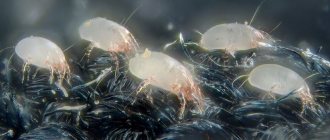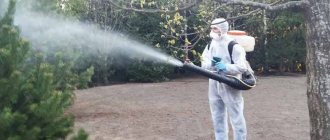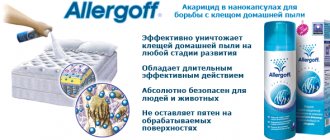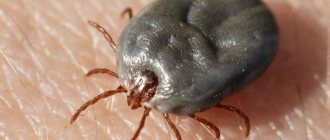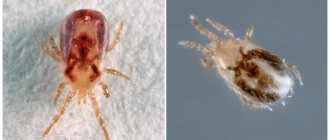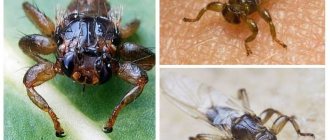Ixodid ticks, or Ixodidae in Latin, are a distinct family consisting of more than 650 different species. Their representatives live all over the globe, in all climatic zones, including the poles. In Russia, the so-called dog and taiga ticks of this genus are most often found. Not only ixodid ticks pose a danger to humans and animals, but also representatives of some other species. If you or your pet were infected with any dangerous disease due to a tick bite, then by and large its scientific classification does not matter. The main thing is to establish whether he was a carrier of the virus and whether he was able to transmit it through a bite.
Ixodid tick activity
Ticks, including ixodid ticks, spend the winter under the cover of snow, fallen leaves and a layer of wilted plants. Such a natural blanket reliably covers them from frost and wind. During this time, the parasite’s body goes into suspended animation, all processes in it slow down and allow the pest to live for almost six months without food or movement. If the tick does not die due to external reasons beyond its control, then its life cycle can reach 7-8 years with periodic falls into lethargy. In order to wake up from a long sleep, the parasite needs the snow to melt, the sun to warm up, and the air temperature to become above zero. Heat gradually accelerates all processes in the tick's body and it wakes up. From this moment on, he has two main goals: nutrition and reproduction. In autumn the situation follows the opposite scenario. The gradual cooling forces the parasite to find a secluded place and hibernate until next spring.
Recommended Links
Have ticks woken up in 2021?
Maps of dangerous areas with encephalitis ticks in the Moscow region and throughout Russia in 2021. Peak periods of tick activity are directly related not only to their life cycle, but also to the weather at the current time.
The most comfortable temperature for them is +18-20 degrees with a relative humidity of 60% or more. As soon as the conditions approach those described above, the mites become active. Warm and humid weather is generally ideal for most species of insects and invertebrates. The higher the values of both indicators, the larger the parasites and the more of them there are. Because of this, the number of pests in different areas of Moscow and adjacent regions at the same time can vary greatly. As a rule, in the Moscow region such weather occurs at the beginning of summer and at the end of autumn. That is why the peak activity of ticks here occurs in April-May and October-November. In 2021, the summer in the capital turned out to be abnormally cold, so the situation with blood-sucking parasites deviated greatly from the classic scenario and time frame. If similar changes continue to occur in the climate, then periods of decline and increase in tick activity will fluctuate.
grass mite
Agricultural pest. There are two types - reddish-brown clover, grass green. They are active from March to mid-spring. Large areas of areas where clover and lawn grass are grown are affected. When there are a large number of pests, the plants dry out and die. Females lay eggs in the soil, young pests emerge the following spring, destroying new plantings. Nymphs differ from adults in a lighter color - almost light green.
Ixodid tick: photo
It is not difficult to spot a tick with the naked eye. In a hungry state, the insect does not exceed 2-4 millimeters in length. It is also distinguished from other parasites by its characteristic drop-shaped shape. The pest has 4 pairs of legs, a torso and a small head. The back can be painted in different shades of black, brown, beige and have spots. Types of ticks differ in color, but it is not at all necessary to understand such subtleties if you are not interested in entomology. For an inexperienced person, the ixodid tick in the photo and in real life at first glance may be no different from other representatives of its species. However, for the fight against parasites and timely assistance to victims of a bite, this is not important, the main thing is to determine that it is a tick in front of you.
A well-fed parasite increases in size several times and gradually turns into a gray shiny ball, about 1-1.5 centimeters in diameter. The tick's body acquires this color due to the blood accumulated in its abdomen. If you find some kind of insect that is literally stuck into your skin, then you can be sure that it is a mite. Most other biting parasites do not spend much time on their victim's body. Sometimes there are situations in which the mite manages to get enough and remove itself from the donor’s skin even before it is discovered. In this case, it is important to understand which insect could have left such a mark. Since the pests completely immerse their heads in the wound while feeding, their bite leaves a fairly large hole in the skin with torn edges. The skin around it becomes very red and swollen. A tick bite, whether it was an ixodid tick or another type, looks the same. People usually find ticks on themselves while they are still present. Parasites most often remain undetected on the bodies of children and pets.
Tick feeding
The basis of the ixodid tick's diet is the blood and lymph of warm-blooded animals - from small rodents to humans. Hungry individuals watch for prey on the surface of grass, dead wood, and bushes, rising up to half a meter from the ground. Having grabbed onto a suitable specimen, they find the area with the thinnest skin, holding on with all eight limbs with claws, suckers and bristles. Having thrust his proboscis into the wound cut by the sharp upper mandibles, the vampire begins a feast that can last up to two weeks.
The duration and volume of food consumed depends on the developmental phase and sex of the individual:
- 3 to 5 days of a leisurely process are enough for the larvae to become twenty times heavier;
- nymphs become saturated within 8 days of being on the victim, increasing their mass by almost 100 (!) times (growing organism);
- adult females stick to the victim for 12 days (if nothing interferes), increasing their weight by 120 times.
This gluttony of adult females is explained by the natural desire to provide the future clutch with the greatest amount of nutrients.
Interesting:
The males, having had a quick snack, devote most of their time to searching for a worthy match for mating.
Prevention against ixodid ticks
Prevention against ixodid ticks helps to avoid bites and all the negative consequences that they can entail.
- If you go into the forest to pick mushrooms, wear closed clothing to prevent ticks from reaching your skin.
- On the banks of reservoirs and in parks, do not lie down or sit in or near tall grass.
- After a trip to the country or any other outing, inspect your clothes, body and hair for insects.
- Use tick repellents that repel and kill ticks.
- Carry a first aid kit with you to safely remove the insect: a tick remover, disinfectant and a container for the tick to have it analyzed.
- Write down in your phone the addresses and contacts of the medical institutions closest to your home, cottage or vacation spot, where you can quickly turn for help.
If you wish, you can also get vaccinated against tick-borne encephalitis. It does not protect against tick bites or any other diseases other than encephalitis, so even if you are vaccinated, the preventive measures described above remain relevant.
Indications for the purpose of the study
The indication for performing the study is the attachment of a tick to the human body.
Ixodidae) are of greatest epidemiological importance
).
Infections transmitted by ixodid ticks are characterized by spring-autumn seasonality from April to October, however, in regions with warm climates, year-round activity of ixodid ticks is observed. Risk groups for the incidence of infections transmitted by ixodid ticks are residents of urban and rural areas who visit tick habitats. Transmission of infectious agents occurs when infected ticks attach themselves to the human body.
Infections transmitted by ixodid ticks include tick-borne viral encephalitis, ixodid tick-borne borreliosis, tick-borne human granulocytic anaplasmosis, human monocytic ehrlichiosis and others (Q fever, Crimean hemorrhagic fever, tularemia, rickettsiosis).
The causative agent of tick-borne encephalitis
— RNA-containing virus of the genus
Flavivirus
. The incubation period of the disease is, as a rule, 7–14 days from the moment of tick bite, but can last up to 25 days. The infection affects the cells of the brain and spinal cord with the subsequent development of paresis and paralysis.
Identification of the causative agent of tick-borne viral encephalitis in a tick allows for timely emergency prevention of infection. If a positive result is obtained, emergency administration of a specific immunoglobulin is indicated - no later than 72 hours from the moment of the bite. The maximum effectiveness of the drug is observed when it is administered during the first day after the bite.
The causative agent of Lyme disease
- spiral-shaped bacterium of the genus
Borrelia
. The disease develops in 20% of cases after sucking on a tick infected with Borrelia. In 50-80% of patients, local skin inflammation is observed - tick-borne migratory erythema (redness), the diameter of which does not exceed 5 cm. When spreading through the blood, Borrelia affects internal organs, cells of the nervous system, as a result of which meningitis, meningoencephalitis, radiculoneuritis, neuritis can develop cranial nerves.
The causative agent of human granulocytic anaplasmosis
- the bacterium
Anaplasma phagocytophilum
, which infects granulocytes - white blood cells containing granules (neutrophils, eosinophils, basophils). Infection occurs through the bite of a tick infected with bacteria called anaplasma.
Symptoms of the disease include prolonged fever, weakness, headache, sweating, cough, nausea, vomiting, diarrhea, muscle and joint pain. The lymph nodes become enlarged, and damage to the kidneys, liver, and spleen may occur. Inflammation of the membranes of the brain and spinal cord is less commonly diagnosed. The incubation period averages 14 days.
The causative agents of monocytic ehrlichiosis
are bacteria belonging to the genus
Ehrlichia
. They enter the human body with tick saliva, enter the blood through the lymphatic tract and begin to multiply in the cells of the inner surface of blood vessels, in white blood cells - monocytes. After the cell is destroyed, microorganisms leave it and infect others. Internal organs (liver, central nervous system, bone marrow, skin) are affected with the development of infectious granulomas. The clinical picture of ehrlichiosis is similar to granulocytic anaplasmosis.
Human granulocytic anaplasmosis, monocytic ehrlichiosis and borreliosis are indications for antibiotic therapy. With timely detection of the disease and treatment, the prognosis is favorable.
Ixodid tick: symptoms
If you are bitten by an ixodid tick, symptoms may relate either to the bite itself and the body's reaction to it, or to the development of a disease that resulted from the bite. The first ones may appear immediately or several hours after the bite. Symptoms of diseases may begin to appear after a week, a month, or even longer, depending on what kind of illness the tick transmitted to you. It is necessary to place the removed tick in some container and submit it for analysis precisely in order to establish whether it could transmit any virus to you even before the first symptoms begin to appear.
A bite can be signaled by:
- Itching and burning in the affected area
- Swelling, hardening, redness, or blue discoloration of the skin at the site of the bite
- Poor blood clotting in a wound left by a tick
- Weakness and chills
- Increased tactile sensitivity and light sensitivity of the eyes
- Body aches, especially in the joints
- Temperature increase
- Increased blood pressure, shortness of breath, headache
A brief description of the symptoms of the most common tick-borne infections can be found here
, however, the diagnosis should only be made by a doctor.
Scabies mite
A parasitic creature of microscopic size. The structural features of the body can only be examined under a microscope. Color grey. The scabies mite lives on the body of humans and animals. It feeds on particles of the skin and secretions of the sebaceous ducts. Adults and nymphs of different ages live under the skin, making numerous passages. Their waste products cause severe itching.
On a note!
Mating of sexually mature individuals occurs at night on the surface of the epidermis. After this, the fertilized female makes her way under the skin, builds her labyrinths, and lays eggs. Infection occurs through contact with a sick person through his things.
Initially, signs of infection appear on the hands - between the fingers, then the tick moves to the genitals, stomach, chest, neck, buttocks, legs. The itching gets worse in the evening and prevents you from sleeping at night. What kind of disease this is can be determined by the symptoms, but a specialist can diagnose the disease and prescribe treatment.
Why are ixodid ticks dangerous?
A tick bite is always unpleasant and scary. However, it is very important at such a moment not to allow yourself to panic, since you may not get away with horror and disgust alone. The main thing that makes ixodid ticks dangerous is viral and bacterial diseases that can be transmitted by insects to humans through the blood at the time of the bite. The most common and dangerous of them include encephalitis, several types of typhoid and rickettsiosis, tularemia, babesiosis and hemorrhagic fever. Most tick-borne infections can be fatal, but most of the deplorable statistics occur in Siberia, the Far East and other areas of the country that are significantly removed from the Moscow region. However, cases of infection with these diseases also occur in the central region of Russia. Treatment and recovery can take long weeks and even months, but if you start it on time, then with almost 100% probability it will lead to a complete recovery.
Due to the fact that tick bites sometimes lead to truly serious consequences, the choice of means that can prevent them is unusually wide. It is best to combine several options at once, focusing on the circumstances. You can put special collars on your pets, completely treat your dacha area for parasites, and use repellent creams, gels and aerosols for yourself, your family and your children. With proper safety precautions, proper attention and timely intervention, tick encounters will not become a large-scale problem.
Spider mite
It poses no danger to humans or animals, since it feeds exclusively on plant juices. Almost invisible, since the size of its body reaches less than 1 millimeter. As a rule, a spider mite is revealed by traces of its vital activity; plant leaves become covered with cobwebs, curl and fall off.
Common spider mite
Destruction of ixodid ticks
It is possible to quickly and effectively exterminate all ticks in any area only with the help of potent chemicals. You can try to treat a private summer cottage yourself using special preparations, however, without expert knowledge in the field of pest control, you can cause serious damage to yourself, your neighbors, your garden, wild and domestic animals. To ensure that the destruction of ixodid ticks does not turn into a natural disaster, you can order the treatment of the entire area at the SES.
- The treatment of the dacha is usually done in just 1 day.
- Pest control protects you from ticks for the entire season.
- The best time for the procedure is the beginning of spring and the end of autumn, but the service can be ordered at any time.
- The treatment is carried out using high-quality, modern products that, when used professionally, do not harm people, animals and plants.
- If necessary, you can order treatment of the area against ticks from Dez Group for the current or next day.
- If you order pest control together with your neighbors for several areas at once, a discount may be provided for each treatment.
Appearance
Externally, the tick resembles a spider. It has an oval body, a small head and eight limbs. The parasite is quite large - its body length ranges from 1 to 10 mm. Its size depends on satiety: a sucked tick increases its size up to 10 times compared to the original one.
An example of an enlarged tick
Females are larger than males. The body is covered with a chitinous shell, which prevents the tick from being torn or crushed. The front part of the body is protected by an armored shield. The integument and digestive system can stretch more than 10 times. Ticks may feed infrequently (some only once in their lives), but very plentifully.
How long does a tick live without food? A very long time. This is an amazingly hardy creature, capable of existing without food for more than one year.
The oral cavity is equipped with a proboscis and sharp teeth “looking” inward, with the help of which mites pierce the skin and suck blood. The bite is accompanied by the release of saliva, which, when frozen, firmly fixes the tick on the food object. A latched tick can stay on the host from a couple of days to one month.
Having eaten, the parasite “rounds up” and significantly increases in volume. A hungry tick is colored black, brown or dark brown, while a saturated tick is red-pink or gray.
The eggs of the pest have a hard, shiny surface, oval shape and brown-brown color. Their average size is 0.5 mm.
